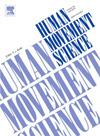注意焦点和动作动词对卧推性能的影响
IF 1.9
3区 心理学
Q4 NEUROSCIENCES
引用次数: 0
摘要
引导个人注意力的口头指示对于优化运动和表现至关重要。虽然之前的研究一直表明,外部注意力比内部注意力更有效地提高运动表现,但在注意力集中指令中嵌入的动作动词的作用仍未得到探索。本研究旨在评估不同的动作动词(推与冲)和注意力焦点(外部与内部)对卧推速度的影响。26名熟悉卧推技术的体力活跃参与者完成了四个条件:ef推、ef冲、if推和if冲。每种情况下都需要在特定的口头指导下重复进行卧推。结果表明,与内部聚焦条件相比,两种外部聚焦条件下的杆速都显著增加,这支持了约束动作假设。此外,动作动词“打”比“推”导致更高的杆速度,这表明动作词影响最大努力任务中的运动表现。注意焦点与动作动词之间没有显著的交互作用,表明它们对成绩的影响是独立的。这些发现强调了使用外部聚焦指令和精心选择的动作词来提高力量和调节任务表现的重要性。该研究有助于我们理解教学线索如何优化抗阻运动的表现,并为教练和从业者设计有效的训练干预提供了实际应用。本文章由计算机程序翻译,如有差异,请以英文原文为准。
Impact of attentional focus and action verbs on bench press performance
Verbal instructions that direct an individual's attention are crucial for optimising movement and performance. While previous research has consistently demonstrated that an external focus of attention enhances motor performance more effectively than an internal focus of attention, the role of action verbs embedded within attentional focus instructions remains unexplored. This study aimed to assess how different action verbs (push vs. punch) and attentional focus (external vs. internal) influence bench press velocity. Twenty-six physically active participants familiar with the bench press technique completed four conditions: EF-push, EF-punch, IF-push, and IF-punch. Each condition involved performing bench press repetitions with specific verbal instructions. Results indicated that both external focus conditions led to significantly greater bar velocities compared to internal focus conditions, supporting the constrained action hypothesis. Additionally, the action verb “punch” resulted in higher bar velocities than “push,” suggesting that action words influence motor performance in maximal effort tasks. No significant interaction effects were found between attentional focus and action verbs, indicating that their effects on performance are independent. These findings highlight the importance of using externally focused instructions and carefully chosen action words to enhance performance in strength and conditioning tasks. The study contributes to our understanding of how instructional cues can optimise resistance exercise performance and suggests practical applications for coaches and practitioners in designing effective training interventions.
求助全文
通过发布文献求助,成功后即可免费获取论文全文。
去求助
来源期刊

Human Movement Science
医学-神经科学
CiteScore
3.80
自引率
4.80%
发文量
89
审稿时长
42 days
期刊介绍:
Human Movement Science provides a medium for publishing disciplinary and multidisciplinary studies on human movement. It brings together psychological, biomechanical and neurophysiological research on the control, organization and learning of human movement, including the perceptual support of movement. The overarching goal of the journal is to publish articles that help advance theoretical understanding of the control and organization of human movement, as well as changes therein as a function of development, learning and rehabilitation. The nature of the research reported may vary from fundamental theoretical or empirical studies to more applied studies in the fields of, for example, sport, dance and rehabilitation with the proviso that all studies have a distinct theoretical bearing. Also, reviews and meta-studies advancing the understanding of human movement are welcome.
These aims and scope imply that purely descriptive studies are not acceptable, while methodological articles are only acceptable if the methodology in question opens up new vistas in understanding the control and organization of human movement. The same holds for articles on exercise physiology, which in general are not supported, unless they speak to the control and organization of human movement. In general, it is required that the theoretical message of articles published in Human Movement Science is, to a certain extent, innovative and not dismissible as just "more of the same."
 求助内容:
求助内容: 应助结果提醒方式:
应助结果提醒方式:


